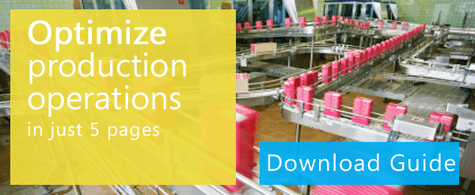
Knowing your target market is crucial to determining how much you should produce or spend during your financial term. Your market will help you determine how resources should be utilized, which equipment and supplies should be invested in and how the goals of the business should be aligned to cater for product demand.
To remain competitive and profitable, manufacturing companies need to leverage the tools at their disposal and carefully manage costs through efficient systems. Using a production schedule software can mean the difference between a company’s increasing or diminishing revenues.
Doing production scheduling manually is time consuming, stressful and prone to errors. Instead of spending hundreds of hours scheduling by hand, you can use a production scheduling software which is fast and more accurate. The software uses advanced mathematical models to simulate the production environment by factoring in various variables and extrapolating a more likely outcome in any given scenario.
Planning Production and Scheduling
Manufacturers can use manufacturing resource planning (MRP) software to allocate raw materials and plan production. MRP is particularly useful for manufacturers that have few products or large runs. However, the software cannot easily handle complex situations such as large units of make-to-order (MTO), orders that change frequently or large numbers of small runs of products. In these scenarios, a planning scheduling software is more effective.
Production scheduling software extends the capability of MRP in four ways:
a) Instead of scheduling all jobs on the chain like MRP does, production software plans and schedules the jobs based on their profitability.
b) The software incorporates lead time in the ordering and receiving of materials, giving managers better estimation of work completion.
c) The software can run several different scenarios of production to create more realistic simulations.
d) The program takes into account other jobs that may be running or that have already been scheduled when planning.
Production scheduling software is best suited for operations that are MTO or assemble-to-order (ATO). The program can also be used in planning productions with large number of components or with complex tasks and/or a work order software module. By using production scheduling software, manufacturers can save significant time and reduce costly errors that result from manual planning or inaccurate simulations made by MRP.
Apart from saving time and reducing errors, using production scheduling program will have a significant impact on your bottom line. The software can help you with inventory management, forward planning and modeling, labor leveling and load balancing.
Benefits of Using Production Scheduling Software
Successful implementation of a production scheduling software can deliver significant benefits to a manufacturing company. The core benefits include:
i) Improved productivity. Get more returns from what you already have by maximizing industrial performance and without increasing your expenses.
ii) Reduced raw material inventory. Synchronize your purchasing with achievable schedule and benefit from innovative inventory strategies.
iii) Reduced make-span time. Reduce the work in process (WIP) that slows down the flow of production. Measure, monitor and improve your industrial performance.
iv) Improved customer service. Increase on-time deliveries and optimize agility in the face of demand uncertainty.
Manufacturing companies looking for accurate visualization, system data integrity, schedule sequence, and co-ordination speed will benefit from implementing a production schedule program.
Visualization: The production schedule software can convert data into a pictorial format, enabling managers to better understand the relationship between the data.
System Data Integrity: The program improves data integrity when generating schedules such as BOM, inventory record, number information, sales order and purchase order. The high integrity enables a company to create feasible schedules and allows other departments to use the system’s details in decision making.
Schedule Sequence: In some industries, scheduling production sequences is critical to the success in production. Setting up sequences reduces setup time and increases machine utilization. The result is longer runs which improve output quality and consistency.
Co-ordination: Co-ordination helps a company to accurately link production, supply and sales activities by the required date.
Using a production scheduling system will improve productivity in your company and free up logistics personnel to be less reactive and more thoughtful when managing operations. With the program in place, employees can focus on strategic elements and the bottom line rather than spending time on the administrative aspects of production scheduling.
